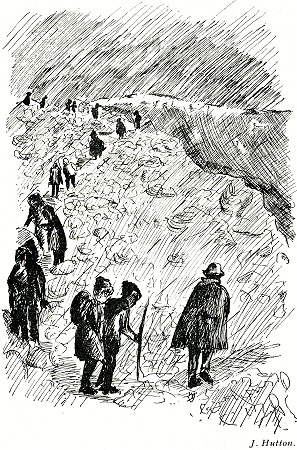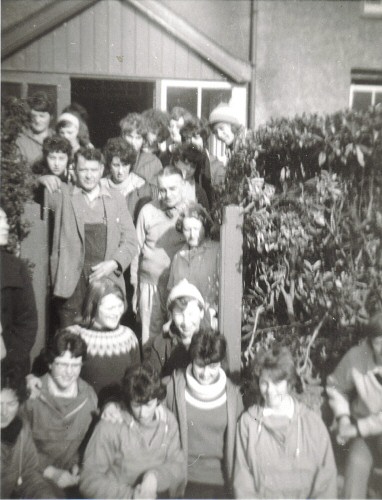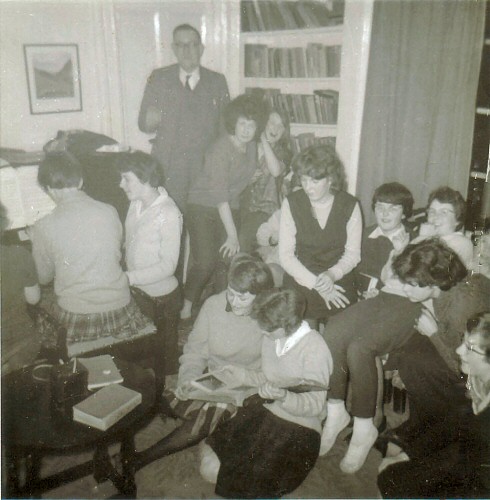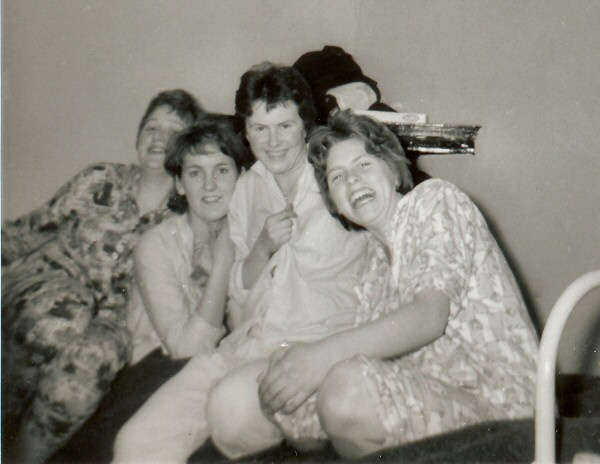THE SCHOOL EXPEDITION TO SNOWDONIA, March 16-23 1963
from the 1963 EHS Magazine
Twenty of the Upper Fourth, Fifth and Sixth Forms went to Wales on a field-course organised by Miss Stanyer, who was assisted by Miss Bunn.
Geologists were able to see many of the structures they had studied in class - like coastlines, U-shaped valleys gouged out by glaciers, hanging valleys, cwms and the formation of bedsof slate - seen clearly at the great quarry at Bethesda which once provided work for 3,000 men. (Now there are 500.)
The visit to Bethesda was interesting: the party arrived in time to see white-helmeted men lay detonators for blasting; all the quarry men ran for shelter, then a series of deafening explosions rocketed echoing round the hills and white puffs of smoke belched up through cracks in the quarry floor along the gallery where mining was in progress. Next we were shown round the sheds, where we saw the slates being cut and split: we were allowed to try splitting slates ourselves - but not always very successfully!
Geography, though it played the largest part in the week's activities, was not the only subject of interest. Many who had not previously known much about the history of Wales now learnt a great deal from visiting Criccieth, Conway and Caernarvon castles - some people also went to look at the Roman fort and museum at Caernarvon, and discovered some odd facts about the Romans.
Biologists found the countryside interesting for its great variety of vegetation, particularly the many varieties of moss to be found on the stones by the mountain streams. Artists found more than enough to occupy their pencils and fill their sketchbooks among the light and shadows, hills and valleys, and no one could have remained blind to the snow-powdered mountains, the clear blue lakes and the swift-flowing rivers frequently breaking into waterfalls.
Most of these pleasures became accessible because we had a skilful, kindly and patient bus-driver. Under his hands the bus performed almost impossible mano[u]evres, turning in narrow places and squeezing along walled roads which all but snapped the side-mirrors off.
He took us north across the Menai Bridge and right across Anglesey through Holyhead to South Stack, where some of the party went down the 403 steps and across the suspension bridge to look round the lighthouse. From Holyhead there is a ferry-service to Dublin - the crossing is over a distance of only sixty miles; it is the shortest from Britain to Ireland.
The party returned from the west side of Anglesey at the end of the day, passing through the village of Llanfair P.G. (Llanfairpwllgwyngwllgogerchwyrndrobwllantisilliogogogoch for short).
The whole company seemed to have become so intoxicated with Welsh air and scenery, certain Welsh legends, the Irish warden's voice, the Welsh caretaker's rolling accent, the cook's superb cooking and the hostel ping-pong table that it was most reluctant to come home.
AUDREY WIMPENNY
PAULINE MORRIS
http://www.penmorfa.com/Slate/penrhyn.html
South Stack Lighthouse
South Stack Lighthouse was built in 1809 in an excellent position just off the N.W. coast of the island of Holyhead. The bridge which connects the lighthouse to the mainland was built in 1826, and 403 steps lead down to it. The lighthouse is run on electricity and gas at 2½,000,000 candle power, 4,000 watt. power, with a voltage of 100 [sic]. The light can be seen for seventeen miles out to sea and the great lens which surrounds it weighs two tons and floats on a bath containing half a ton of mercury, and this prevents any friction. The lens turns one revolution every minute while the light flashes every ten seconds.
http://www.trinityhouse.co.uk/events_and_leisure/visitor_centres/south_stack.html
At Bryn Dinas: The Snowdonia Holiday Fellowship Hostel
We arrived at the hostel at about 5 o'clock on Saturday and assembled in the dining hall. Here we were given our sleeping bags, mine was already torn but it didn't matter as other people's (by the end of the week) were as well.
We were warned by the warden at supper on Saturday that the hostel was rather primitive, he said that if it started to rain we should find buckets to catch the water in, in the kitchen. He also warned us against drinking water from the taps as it was pumped from a mountain stream and hadn't been purified.
As it didn't rain much except on Sunday we didn't find the buckets necessary, drinking water was more of a problem as it took about an hour to get a jug of drinking water through the filter. Another problem was the gas-lighting as the gas leaked into room one (what a smell) and was therefore turned off during day after the first day. This meant, that one had to walk upstairs in the pitch dark, find one's torch (which someone had usually moved) and turn the gas on at the main cylinder before one could attempt to light anything.
However, in spite of all our problems, which surprisingly enough no one fussed about, we were very happy. The scenery from the hostel windows was very beautiful and one day we found a sheep and her lamb in the front garden.
The food was very good and the cook was nicknamed by the party Emma Jane. The warden was very nice and most amusing and in the evenings he told us of his experiences in other hostels. He did not want to be photographed and Miss Bunn had to engage him in conversation before Joey could take his photo. The photo however, is a very good likeness.
In all we enjoyed our holiday very much and were sorry to leave especially as leaving meant coming back to school.
MARY GOODRICH, U.IV 1
Fortiter - But ...For those who are ignorant about such matters, the picture depicts seventeen members of the High School, Ely, demonstrating how NOT to climb a mountain. Unfortunately, due to excess precipitation at higher altitudes Yr Wyddfa (Snowdon 3,560 ft.) remained unclimbed by us, partly because we could not see where we were going, and partly because we had taken so long to climb the first thousand odd feet that we would not have reached the top by Easter, let alone tea-time! The only criticism there was about the locality was that the cloud was so thick (we of course were in it) that even if we had decided to move, we could not have as the mist was thicker than the Warden's tea (which tells you what the Warden's tea was like). It did however thin (the mist, not the tea), and at once it began to snow. This event was followed by some violent movements and a swift descent of Clogwyn du'r Arddu, the hill we were on. Naturally by the time we had reached the Snowdon Ranger Hostel (which marked the beginning of the path) there was hardly a cloud in sight, the rain had stopped, and so disappointed people went off for tea (and incomprehensible Welsh television) at the Prince Llewellyn Hotel in Beddgelert. JEAN THORNTON, V 1. |
 |
Night in the Hostel Annexe
There were 8 of us in the Annexe - that means at the top of a stone-built barn 30 yards from the main building. When we went to bed we ran across the yard with a torch, up a flight of concrete steps and opened the door. The large black shapes looming inside were only the double bunks, so we felt for the matches and lit the gas lamp in the middle of the room.
Thankfully we got undressed, and invariably had to search for our missing pyjamas which someone had thoughtfully hidden. Once inside one's sleeping bag, it was fascinating to watch the others. Each wore thick sweaters, most wore socks, one a pair of fur gloves, one wore her grey duffle coat and insisted on putting up the hood while the last into bed wore a pink striped nightshirt over a green sweater, blue pyjama trousers, plus a headscarf. She had to pull out the light, then yell for her torch to see her way back to bed.
A small beam of light at the other end of the room indicated that peanuts and cheese biscuits were being hastily devoured. Soon there was silence, then water began monotonously dripping into the tank, and an eerie cry was heard every few seconds - but it was only an owl. Was that footsteps outside? - but who would hear us if we screamed? - a timid voice in the corner said, "I'm scared!" and this sentiment was echoed by others, and laughed at by the less imaginative.
Soon, one brave soul was forced to get out and lock the door, then everybody felt better. Rain pattered on the skylight, then a beam of light suddenly appeared on the ceiling, and moved over in the opposite direction from the car which was passing, then all was quiet again - except for the owl, and the constant drip, drip in the tank.
Next morning, alternate thuds and rumbles from beneath us, woke us up it was the caretaker - shovelling coal and chopping wood at 6.0 a.m.! A voice murmured that it was sure somebody had sleep-walked past their bed during the night; but in the daylight, everything looked strangely ordinary - especially a line of laundered underwear slung between two bunks! Ice cold water was in the taps for those brave enough to wash - and with all these assets we wouldn't have swapped the annexe for anything.
"BARN OWL".
Budding Television Stars
It was Wednesday afternoon in Conway and we were passing the time until we had to be back at the bus, exploring the town. Outside an old Elizabethan house called "Plas Mawr" we saw a sign advertising a Haunted Room. For a while we pondered as to whether it was of any historical interest, and, if it was, whether we had enough time for we had to be back at the bus in about fifty minutes. Finally we entered, and, as there was nobody there to take our money, we wandered further in. When we had passed through the turnstile an old lady appeared and we dutifully handed over our sixpences.
We passed through into a courtyard, and, just at that moment, another visitor came up to the old lady and introduced himself to her as a television news feature camera man for Teledu Cymru. He wished to film the house as it was being extensively restored at the cost of £45,000.
We were curious to know how a television camerman went about his work and we hoped that we might be able to watch him filming the deteriorating condition of the building. However we were not exactly bold enough to ask him outright but, fortunately, later, as we were looking around the rooms, with their uneven wooden floors and embossed walls and ceilings, we were surprised by the camera man who was surveying the rooms for their photographic potential.
We asked him about his work and, much to our delight, he asked us if we would like to help him by allowing him to film us looking around and thus link up the shots in various parts of the house.
First of all, he only had one of us walking across the room, flicking some dust away and then going out of camera range. He retook the flicking away of the dust so that a close up of the hand could be inserted for, as he explained, all films were cut and edited before they were shown. He then took a shot of us walking fast across an empty disused room. Before actually filming, he would give us a rough idea of what he wanted and then we would have a quick rehearsal.
We then realised how complicated filming can be, for, having taken a shot of us going down an old spiral staircase, he had to get to the bottom and film us again from that angle.
Afterwards we went out into a courtyard and he filmed us inspecting the repair materials and watching the builders hauling a slab up with a pulley. As he now had several feet still unused he said we could do as we wished for the next shot. We walked up to the dusty lead windows and curiously peered into them and pointed at what could be seen.
The filming done, we wondered if anyone would believe our account when we rejoined the party, but Mr. Owen, as he was called, kindly wrote a note stating that we had taken part in a feature for Teledu Cymru, which would be shown either the following night or the next.
Unfortunately it was not shown the following night and our visit to the Prince Llewelyn Hotel, the nearest television to us as there was only gas at the hostel, was in vain and we never saw ourselves on the screen.
IRIS FIRBY
LINDA WILLETTS
JACKIE BIDWELL.
https://www.bbc.co.uk/wales/northwest/sites/conwy/pages/plasmawr.shtml
Margaret Cockburn née Allen provides some photos:

Outside the hostel: source Margaret Cockburn née Allen

Mary Goodrich at the piano with Linda Willetts. Margaret
Boon and Mary Wilkins near the bookshelves. Myself and Jackie
on the floor, Rosemary Broomfield, Pauline Morris, Iris
Firby, ? and Anne Covey-Crump.
source Margaret Cockburn (née Allen): IDs Margaret, Jackie
Sotheran (née Bidwell)

Anne Covey-Crump - Rosemary Broomfield - Iris Firby -
Margaret Allen
source: Jackie Sotheran (née Bidwell): IDs Jackie Sotheran

At Criccieth Castle: Rosemary Broomfield, Margaret Allen (on
the grass), Mary Wilkins, Audrey Wimpenny, Linda Willetts and
Jackie [Bidwell].
source Margaret Cockburn née Allen
Page created 6 Jul 10, updated 11 Aug 11
If you can add recollections or photos to this page please contact us